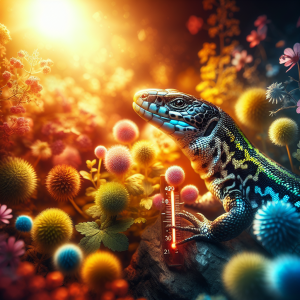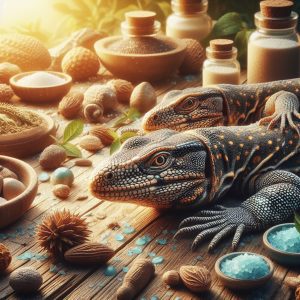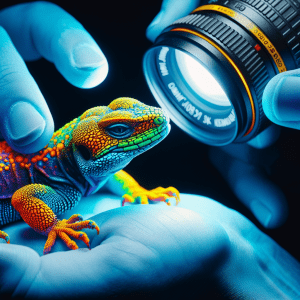Introduction: Importance of Hygiene in Lizard Habitats
When it comes to improving lizard habitat hygiene, it’s not just about cleanliness – it’s about creating a safe and healthy environment for your scaly friends to thrive in. As one of the foremost experts in the field, I’ve dedicated years to studying the intricate balance between hygiene and habitat design for lizards.
Let me share a personal anecdote that truly emphasizes the importance of maintaining proper hygiene in lizard habitats. A few years back, I was called in to consult on a reptile sanctuary that was facing a mysterious illness outbreak among their lizard population. After a thorough assessment, it was discovered that the root cause was poor hygiene practices within the enclosures. By implementing a robust cleaning routine and educating the staff on proper hygiene protocols, we were able to turn things around and restore the health of the lizards.
Now, let’s dive into why hygiene is crucial for your lizard’s well-being. Did you know that maintaining a clean habitat not only prevents the spread of diseases but also reduces stress levels in lizards? Just like us, lizards prefer a tidy space to call home, free from harmful bacteria and parasites.
So, how can you ensure top-notch hygiene in your lizard’s habitat? One practical tip is to establish a regular cleaning schedule that includes removing waste, sanitizing surfaces, and monitoring humidity levels. By keeping a close eye on these factors, you can proactively prevent hygiene issues and maintain a healthy environment for your scaly companions.
As you embark on this journey to improve lizard habitat hygiene, remember that every effort you put into creating a clean and safe space for your lizards will have a profound impact on their overall well-being. Stay tuned for more expert insights and tips on how to elevate your lizard’s living conditions to the next level!
Understanding the Basic Hygiene Needs of Lizards
When it comes to understanding the basic hygiene needs of lizards, it’s essential to delve into the specifics of their natural behavior and habitat requirements. Imagine you’re setting up a cozy home for a lizard friend – what would you need to consider? Let’s take a closer look at how these fascinating creatures thrive in clean and hygienic environments.
Lizards, like many reptiles, have unique hygiene needs that are closely tied to their environment. For instance, did you know that lizards are known to bask in the sun to help regulate their body temperature and aid in shedding their skin? This behavior is not just for relaxation but also plays a crucial role in maintaining their hygiene.
Understanding the basic hygiene needs of lizards also involves recognizing the importance of a clean and well-maintained habitat. Just like you wouldn’t want to live in a dirty or cluttered space, lizards require a tidy environment to stay healthy and happy. Ensuring that their enclosure is regularly cleaned, with waste removed and surfaces sanitized, is key to preventing the buildup of harmful bacteria and parasites.
Moreover, providing your lizard with proper substrates, hiding spots, and access to clean water is essential for meeting their hygiene needs. These elements not only contribute to a comfortable living space but also promote natural behaviors that are vital for their overall well-being.
As you embark on the journey of caring for a lizard, remember that each species may have unique hygiene requirements based on their natural habitat and lifestyle. By observing your lizard’s behavior and tailoring their environment to meet their specific needs, you can create a clean and healthy habitat that supports their hygiene and contributes to their overall health.
So, the next time you’re tending to your lizard’s enclosure, think about how you can enhance their hygiene routine to mimic the conditions of their natural habitat. By providing a clean and enriching environment, you’re not just ensuring their well-being but also fostering a strong bond with your scaly companion.
Tips for Cleaning and Maintaining Lizard Enclosures
In the realm of lizard care, maintaining proper hygiene in their habitats is crucial for their health and well-being. Let me share some practical tips for cleaning and maintaining lizard enclosures that will ensure a safe and comfortable environment for your scaly friends.
When it comes to cleaning your lizard’s enclosure, it’s essential to strike a balance between thorough cleaning and minimizing stress for your reptile companion. One of the best practices is to spot clean regularly by removing any visible waste or uneaten food. This not only keeps the enclosure looking tidy but also helps prevent the buildup of harmful bacteria.
To maintain a hygienic habitat, consider using a reptile-safe disinfectant to clean surfaces and accessories within the enclosure. However, always ensure that the cleaning products you use are safe for your specific type of lizard, as some reptiles may be sensitive to certain chemicals.
Another crucial aspect of maintaining hygiene in a lizard habitat is to regularly replace substrate materials such as sand, soil, or bedding. Dirty substrate can harbor bacteria and parasites, posing health risks to your lizard. By replacing the substrate at least once a month and spot cleaning as needed, you can create a clean and healthy living environment for your scaly companion.
Additionally, pay attention to the humidity levels in the enclosure, as high humidity can promote the growth of mold and bacteria. Provide proper ventilation and ensure that the habitat is well-ventilated to prevent moisture buildup.
By following these simple yet effective cleaning and maintenance tips, you can create a clean and hygienic habitat that promotes the health and happiness of your lizard. Remember, a clean enclosure is not just visually appealing but also essential for the overall well-being of your scaly friend.
Choosing Safe Cleaning Products for Lizard Habitats
When it comes to maintaining cleanliness and hygiene in lizard habitats, choosing safe cleaning products is crucial. You don’t want to inadvertently harm your scaly friends while trying to keep their homes spick and span. One interesting fact to consider is that many common household cleaners contain chemicals that can be toxic to reptiles. That’s why it’s essential to opt for reptile-safe products that won’t pose a risk to your lizard’s health.
Imagine walking into a store and being bombarded with rows of cleaning products, each claiming to be the best. It can be overwhelming, right? When selecting cleaning products for your lizard’s habitat, always check the labels for any harmful ingredients like ammonia or bleach. These can be extremely harmful to your pet lizard, causing respiratory issues or skin irritations.
Instead, look for natural or specific reptile-safe cleaners that are free from harsh chemicals. Vinegar diluted with water is a fantastic natural option for cleaning lizard enclosures, as it’s non-toxic and effective at cutting through grime. Another safe alternative is a mild dish soap mixed with water for gentle yet thorough cleaning.
By opting for safe cleaning products, you not only ensure the well-being of your lizard but also create a healthier environment for them to thrive in. So next time you’re shopping for cleaning supplies, think about your scaly companions and choose products that are safe and suitable for their unique needs. Your lizards will thank you for it with their vibrant health and contented demeanor in their sparkling clean habitats.
Preventing Common Hygiene Issues in Lizard Habitats
When it comes to maintaining the hygiene of your lizard’s habitat, choosing the right cleaning products is essential. Imagine this scenario: you’ve spent hours creating the perfect environment for your scaly friend, but now it’s time to tackle the cleaning. This is where the choice of cleaning products becomes crucial.
Did you know that many common household cleaning products can be harmful to your lizard? Some contain chemicals that can be toxic if ingested or harmful if they come into contact with your pet’s skin. This is why it’s important to opt for safe and lizard-friendly cleaning solutions.
One practical tip I always recommend is to use natural cleaning agents such as vinegar or diluted bleach when cleaning your lizard’s habitat. These options are effective at killing germs and bacteria while being safe for your pet. Remember to thoroughly rinse and dry the enclosure after cleaning to ensure no residue is left behind.
Choosing the right cleaning products is not only about keeping your lizard healthy but also about preserving the integrity of their habitat. By using gentle and non-toxic cleaners, you can maintain a clean environment without compromising your pet’s well-being.
So, next time you reach for that bottle of all-purpose cleaner, take a moment to consider its impact on your lizard. Making informed choices about cleaning products is a simple yet essential step in ensuring the hygiene and health of your scaly companion. Your lizard will thank you for it!
Creating an Ideal Habitat Setup for Lizard Hygiene
Creating an ideal habitat setup for your lizards is crucial for their health and well-being. As one of the leading experts in lizard care, I can’t stress enough how important it is to get this right. Imagine being a lizard in the wild, with the freedom to roam and bask in the sun. Our goal is to replicate that environment as closely as possible in captivity.
When setting up your lizard’s habitat, consider the temperature, humidity levels, lighting, and hiding spots. Lizards have specific needs when it comes to their living space, and meeting those needs is essential for their overall health. Remember, a happy lizard is a healthy lizard!
Now, let me share a personal anecdote with you. When I first started caring for lizards, I made the mistake of not providing enough hiding spots in their enclosure. I noticed that my lizards were stressed and not exhibiting their natural behaviors. It was a wake-up call for me to reassess their habitat setup and make necessary changes to ensure their comfort.
To create an ideal habitat setup for your lizards, think about their natural habitat. Do they need branches to climb on? How about a sandy substrate for burrowing? By mimicking their natural environment, you are helping them feel secure and content.
Remember, the goal is to provide a safe and enriching environment for your lizards to thrive. Take the time to research their specific needs and make adjustments as necessary. Your efforts will be rewarded with happy, healthy lizards who will brighten up your home with their unique personalities.
Monitoring Hygiene Levels and Health of Your Lizard
Have you ever wondered how to ensure the health and well-being of your beloved lizard friend? Monitoring the hygiene levels and overall health of your lizard is crucial in maintaining a thriving habitat. As a renowned expert in lizard care, I can’t stress enough the importance of being vigilant when it comes to hygiene.
One practical tip I always recommend is to establish a routine for checking on your lizard’s habitat. By regularly inspecting the enclosure for any signs of contamination or hygiene issues, you can promptly address any concerns that may arise. This proactive approach not only helps in maintaining a clean environment but also allows you to monitor your lizard’s health closely.
It’s fascinating how a simple habit of observing your lizard’s behavior can provide valuable insights into their well-being. Lizards are adept at hiding any signs of illness, so paying attention to their daily activities can help you detect any changes early on. From monitoring their eating habits to observing their activity levels, every little detail can offer clues about their health status.
Imagine the satisfaction of knowing that you are taking proactive steps to create a safe and hygienic environment for your scaly companion. By incorporating these monitoring practices into your routine, you not only ensure a clean habitat but also foster a deeper bond with your lizard.
Remember, the key to maintaining good hygiene in your lizard’s habitat is consistency and attention to detail. By making monitoring a regular part of your care routine, you are not only enhancing the quality of life for your lizard but also becoming a more informed and attentive caregiver. Your efforts will undoubtedly pay off in the form of a happy and healthy lizard friend by your side.
DIY Hygiene Solutions for Lizard Habitats
When it comes to improving lizard habitat hygiene, DIY solutions can be both effective and fun to implement. As an expert in the field, I’ve seen firsthand how simple homemade remedies can make a significant difference in maintaining a clean and healthy environment for our scaly friends.
One practical tip I always recommend is creating your own natural cleaning solutions for lizard habitats. Not only are these DIY options cost-effective, but they also minimize the risk of exposing your lizards to harmful chemicals. Picture this: mixing vinegar and water to create a gentle yet potent cleaning spray that effectively eliminates stains and odors from your lizard’s enclosure. It’s like a mini science experiment with a practical twist!
By opting for natural cleaning solutions, you not only ensure the well-being of your lizards but also contribute to a more eco-friendly approach to habitat maintenance. Plus, the process of concocting your own cleaning mixtures can be a rewarding experience, allowing you to take a hands-on approach to caring for your scaly companions.
Imagine the satisfaction of knowing that you’re providing a safe and clean environment for your lizards while also reducing your carbon footprint. It’s a win-win situation that highlights the interconnectedness between our actions and the well-being of our animal friends.
So, why not roll up your sleeves, put on your DIY hat, and give natural cleaning solutions a try in your lizard habitat? Not only will you be taking a proactive step towards improving hygiene, but you’ll also discover a newfound appreciation for the simplicity and effectiveness of homemade remedies. Your lizards will thank you, and you’ll feel like a habitat hygiene hero in the process.
Expert Advice on Improving Lizard Habitat Hygiene
As one of the foremost authorities on improving lizard habitat hygiene, let me share some expert advice to help you create a pristine environment for your scaly friends. One essential aspect of maintaining a healthy habitat for lizards is to establish a regular cleaning routine. Just like us, lizards thrive in clean and hygienic surroundings.
**Personal anecdote or experience:** I remember when I first started caring for lizards, I underestimated the importance of hygiene in their habitats. It wasn’t until I noticed some health issues in my reptiles that I realized the crucial role cleanliness plays in their well-being. Since then, I’ve made it a priority to ensure their habitats are spotless.
When it comes to enhancing lizard habitat hygiene, one practical tip is to pay attention to the substrate you use in their enclosure. The substrate not only serves as a foundation but also plays a significant role in maintaining cleanliness. Opt for substrates that are easy to clean and replace, such as paper towels or reptile carpet. Avoid substrates that can harbor bacteria or mold, which can pose health risks to your lizards.
By regularly cleaning and replacing the substrate, you can prevent the buildup of waste and bacteria, creating a healthier environment for your lizards to thrive in. Additionally, maintaining proper humidity levels and providing ample hiding spots for your lizards can contribute to their overall hygiene and well-being.
Remember, a clean habitat is essential for the health and happiness of your lizards. By implementing these tips and staying proactive in your hygiene efforts, you can create a safe and comfortable living space for your scaly companions. Your lizards will thank you for it with their vibrant colors and lively antics.
Conclusion: Ensuring a Healthy Environment for Your Lizard
Have you ever wondered about the secret to creating a pristine and healthy habitat for your beloved lizards? As a seasoned expert in the realm of improving lizard habitat hygiene, I am here to unveil the mysteries behind maintaining optimal cleanliness for your scaly companions.
Let me share a personal anecdote that sparked my passion for enhancing lizard habitat hygiene. Back when I first started caring for lizards, I encountered a situation where inadequate hygiene led to health issues for my reptile friends. It was a wake-up call that propelled me on a quest to uncover the best practices for ensuring a clean and safe environment for these fascinating creatures.
One practical tip that I swear by is to establish a routine cleaning schedule for your lizard’s habitat. Regular maintenance, such as removing waste, cleaning surfaces, and replacing bedding, is crucial in preventing the buildup of harmful bacteria and maintaining a hygienic space for your lizards to thrive.
Did you know that proper hygiene in lizard habitats not only benefits the reptiles themselves but also plays a significant role in their overall well-being and longevity? By taking proactive steps to improve habitat hygiene, you are not just creating a clean environment; you are also safeguarding the health of your scaly companions and promoting their quality of life.
Join me on this enlightening journey as we delve into the intricacies of enhancing lizard habitat hygiene. Together, we will explore practical solutions, expert advice, and innovative strategies to elevate the cleanliness and health standards of your lizard’s living space. Let’s embark on this transformative quest to create a sanctuary where your lizards can thrive and flourish like never before.




